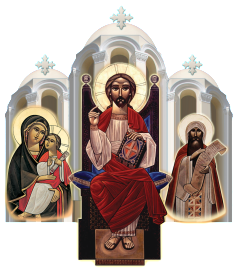St. Longinus the Soldier
“For my thoughts are not your thoughts, neither are your ways my ways, declares the Lord.”
The Lord works in mysterious ways. Things that, to our knowledge and perception, appear to be heading in one direction, could, through God’s Providence, conclude with an entirely unexpected result. The story of St. Longinus, the centurion who presided over the Crucifixion and pierced Christ’s side with a spear, is one such testimony of God’s mysterious mercy.
St. Longinus was not born a saint, nor was he a Jew awaiting the Messiah. He was a Greek from the region of Cappadocia, raised a Gentile and a pagan, far removed from the covenants, prophecies, and God’s promise to redeem His creation. By enlisting in the Roman army, he had chosen a life marked by violence, conquest, and abuse. In short, he was distant from the light of Christ.
Yet the light of Christ was not far from him. On that fateful Friday outside Jerusalem, Longinus encountered the crucified Jesus, and everything changed. Longinus did not see the Lord transfigured in glory on Mount Tabor, nor performing miracles in Galilee, but mocked, abandoned, stripped, and nailed to the Cross. He was not there to be converted by Jesus or to seek a sign. Yet, the sign presented itself anyway. He saw the sun hide its face, the earthquake, the stones split, and the graves open up to release some of their dead. More striking still, he witnessed the Man Himself: suffering silently, forgiving His executioners, and entrusting His spirit to the Father.
When Jesus breathed His last, Longinus pierced His side to confirm His death: “and at once there came out blood and water” (John 19:34). At that point, Longinus was no longer the same. It was his own heart that was pierced by the divine love, humility, and truth. Realizing that the Man they were crucifying was innocent, he confessed with faith: “Truly this was the Son of God” (Matt. 27:54; Mark 15:39; Luke 23:47).
Tradition tells us that Longinus may have suffered from impaired eyesight, and that when drops of Christ’s blood touched his eyes, he was healed. Whether historically verifiable or not, the spiritual symbolism is certain. This man, who was born a sightless pagan, doubtlessly had his eyes opened that day and saw the “Light of the world” (John 8:12). As St. John Chrysostom reflects on this moment of sight and faith: “The centurion became the first fruit of the Gentiles; for he bore witness, not after the Resurrection, but while the very events were taking place. When the others were mocking, he alone confessed Christ.”(Homily on Matthew 88.1)
Longinus’s witness did not end at Calvary. He was also in charge of guarding the Tomb. There, he encountered the greatest sign of all, the Man whose death he had just concluded, resurrect and come out of the tomb while it was sealed. Longinus with two of his companions, rejected the bribe offered by the chief priests to conceal the truth of the Resurrection. Instead, he confessed Christ openly, baptized at the hands of St Peter, abandoned his military career, and returned to Cappadocia to preach the Gospel. Through his testimony, many came to faith, and the Lord worked miracles through him.
But the enemy of souls did not rest. Reports of the centurion-turned-preacher reached Pontius Pilate, who in turn wrote to Tiberius Caesar. Soldiers were dispatched to arrest Longinus. Remaining steadfast, he embraced martyrdom and was beheaded on the 23rd of Abib (July 30) in the year 45 AD. Thus, the one who once pierced Christ’s side was himself pierced by the sword of martyrdom and crowned with eternal glory “surrounded by so great a cloud of witnesses” ( Heb. 12:1) interceding for the faithful.
May his blessings and prayers be with us all, and glory be to our God forever and ever amen.
Sources

